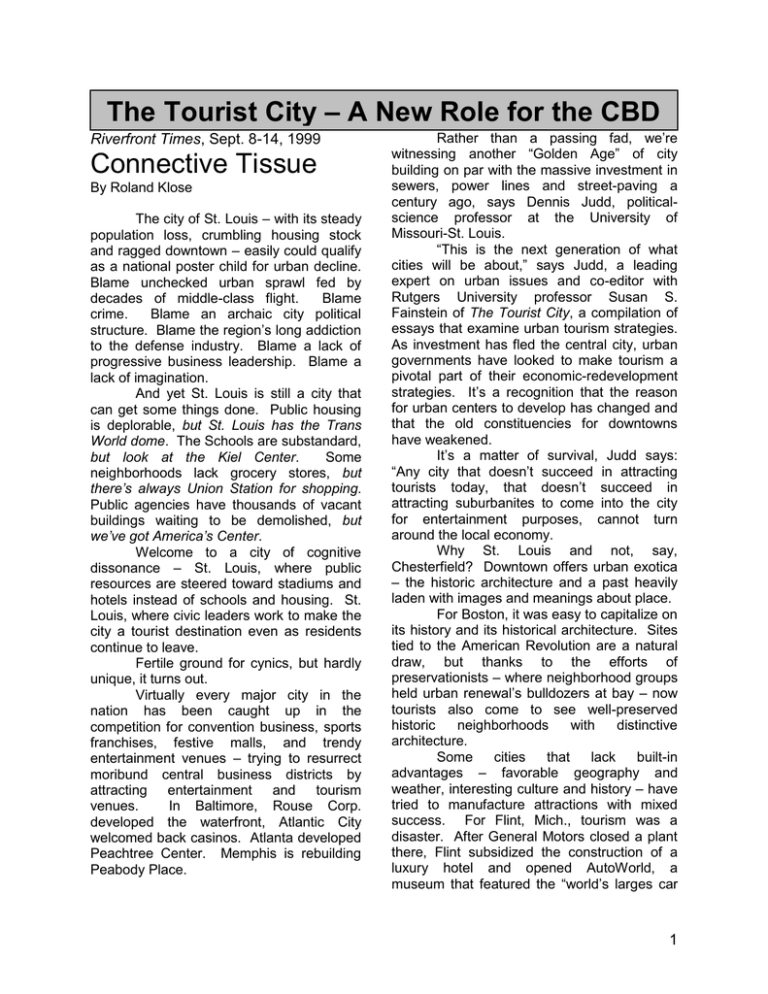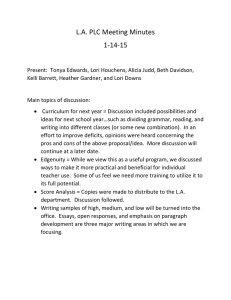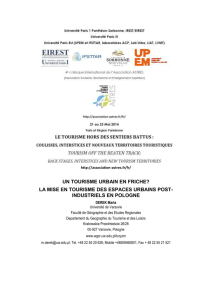The Tourist City - Urban Geography
advertisement

The Tourist City – A New Role for the CBD Riverfront Times, Sept. 8-14, 1999 Connective Tissue By Roland Klose The city of St. Louis – with its steady population loss, crumbling housing stock and ragged downtown – easily could qualify as a national poster child for urban decline. Blame unchecked urban sprawl fed by decades of middle-class flight. Blame crime. Blame an archaic city political structure. Blame the region’s long addiction to the defense industry. Blame a lack of progressive business leadership. Blame a lack of imagination. And yet St. Louis is still a city that can get some things done. Public housing is deplorable, but St. Louis has the Trans World dome. The Schools are substandard, but look at the Kiel Center. Some neighborhoods lack grocery stores, but there’s always Union Station for shopping. Public agencies have thousands of vacant buildings waiting to be demolished, but we’ve got America’s Center. Welcome to a city of cognitive dissonance – St. Louis, where public resources are steered toward stadiums and hotels instead of schools and housing. St. Louis, where civic leaders work to make the city a tourist destination even as residents continue to leave. Fertile ground for cynics, but hardly unique, it turns out. Virtually every major city in the nation has been caught up in the competition for convention business, sports franchises, festive malls, and trendy entertainment venues – trying to resurrect moribund central business districts by attracting entertainment and tourism venues. In Baltimore, Rouse Corp. developed the waterfront, Atlantic City welcomed back casinos. Atlanta developed Peachtree Center. Memphis is rebuilding Peabody Place. Rather than a passing fad, we’re witnessing another “Golden Age” of city building on par with the massive investment in sewers, power lines and street-paving a century ago, says Dennis Judd, politicalscience professor at the University of Missouri-St. Louis. “This is the next generation of what cities will be about,” says Judd, a leading expert on urban issues and co-editor with Rutgers University professor Susan S. Fainstein of The Tourist City, a compilation of essays that examine urban tourism strategies. As investment has fled the central city, urban governments have looked to make tourism a pivotal part of their economic-redevelopment strategies. It’s a recognition that the reason for urban centers to develop has changed and that the old constituencies for downtowns have weakened. It’s a matter of survival, Judd says: “Any city that doesn’t succeed in attracting tourists today, that doesn’t succeed in attracting suburbanites to come into the city for entertainment purposes, cannot turn around the local economy. Why St. Louis and not, say, Chesterfield? Downtown offers urban exotica – the historic architecture and a past heavily laden with images and meanings about place. For Boston, it was easy to capitalize on its history and its historical architecture. Sites tied to the American Revolution are a natural draw, but thanks to the efforts of preservationists – where neighborhood groups held urban renewal’s bulldozers at bay – now tourists also come to see well-preserved historic neighborhoods with distinctive architecture. Some cities that lack built-in advantages – favorable geography and weather, interesting culture and history – have tried to manufacture attractions with mixed success. For Flint, Mich., tourism was a disaster. After General Motors closed a plant there, Flint subsidized the construction of a luxury hotel and opened AutoWorld, a museum that featured the “world’s larges car 1 engine.” Both the museum and the hotel closed, and Flint ended up lampooned in Michael Moore’s Roger and Me. Some success stories can’t easily be replicated. Cancun developed as a resort because of natural resources and heavy support from the Mexican government. Las Vegas was built, and continues to prosper, because of the legalization of gambling in 1931. Orlando had location, as well as compliant local and state governments willing to cede extraordinary control to Walt Disney. Other cities, like Baltimore with its Harborplace and San Antonio with the Riverwalk, created what Judd calls “tourist bubbles” – safe and sanitized enclaves for visitors that have little relation to the city outside them. St. Louis receives only fleeting references in The Tourist City. It’s clearly not among the cities Judd views as touristfriendly, despite its heavy investment in tourism and entertainment venues. “We have a state-of-the-art convention center and football stadium. We’re investing a hunk of money in a convention center. We’re talking about building another baseball stadium. We have a very successful Rouse mall (Union Station). We have all these components, but the problem with St. Louis is, we haven’t linked them together.” Judd says downtown St. Louis offers a collection of venues – sports arenas, museums and malls – that aren’t tied in a way that encourages people to spend time downtown, sampling the experiences that make visiting an urban center a unique cultural experience. Prt of the blame goes to the lack of coordinated public planning, which Judd says owes much to the patchwork quilt of governmental authority in the city. The legislative body is carved into 28 single-member districts, with few aldermen able to look past the interests of their wards. The mayor occupies a weak office in which he shares key budgetary and personnel decisions with other elected officials. Even strong personalities who’ve held the mayor’s job haven’t been able to overcome the limitations of the office, Judd says. “In St. Louis, it’s hard for a mayor to assert leadership. He doesn’t have the institutional capacity to assert leadership,” Judd says. Governmental structure, however, isn’t the biggest obstacle to effective urban planning, Judd says, and therein is a lesson for St. Louis. Political and economic power, he contends, still is centered in a “very conservative corporate white male culture.” Civic Progress, the organization of corporate chief executive officers that continues to carry considerable clout on major issues, goes to bat for projects that make money for them. “But to get anything that has a bigger, more ambiguous public purpose – everyday amenities like vest-pocket parks, pedestrian malls, coffeehouses, places where people want to eat – it’s hard to get the civic elite on board, because they don’t see how they make money.” That’s why Judd gives high marks to the proposed Downtown Development Action Plan, a Harmon-administration initiative. Judd says the plan appears to provide the “connective tissue” that will tie the city’s multimillion-dollar investments together and make the central city a place where tourists will visit and return. The plan calls for new housing, additional parking, pedestrian promenades and a new attraction along the Gateway Mall. Judd cautions that cities that succeed tend to “have a participatory civic culture” that invites citizens’ groups and neighborhood organizations into the planning process. A city, after all, “depends on the efforts of ordinary people,” Judd says. 2



